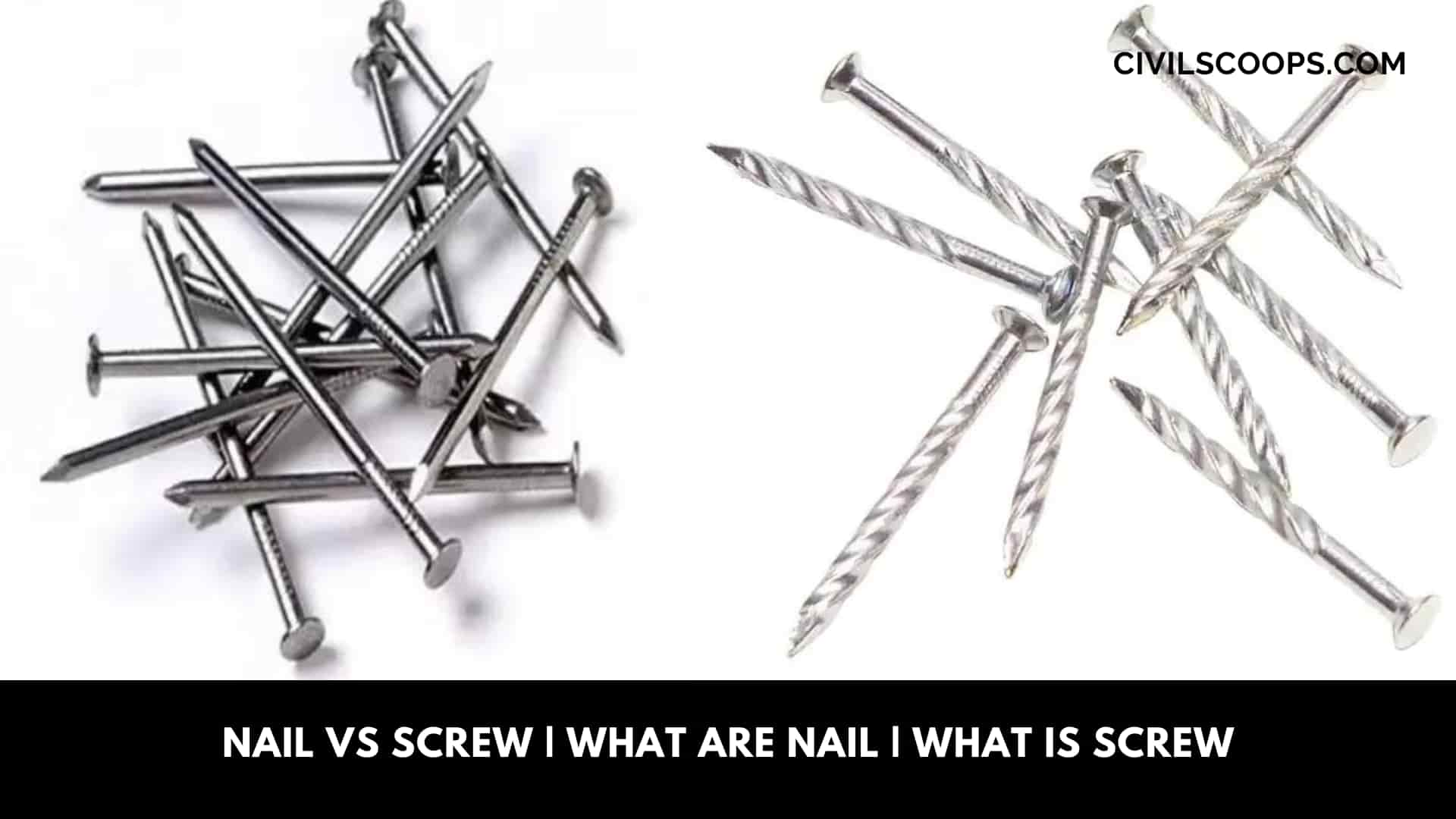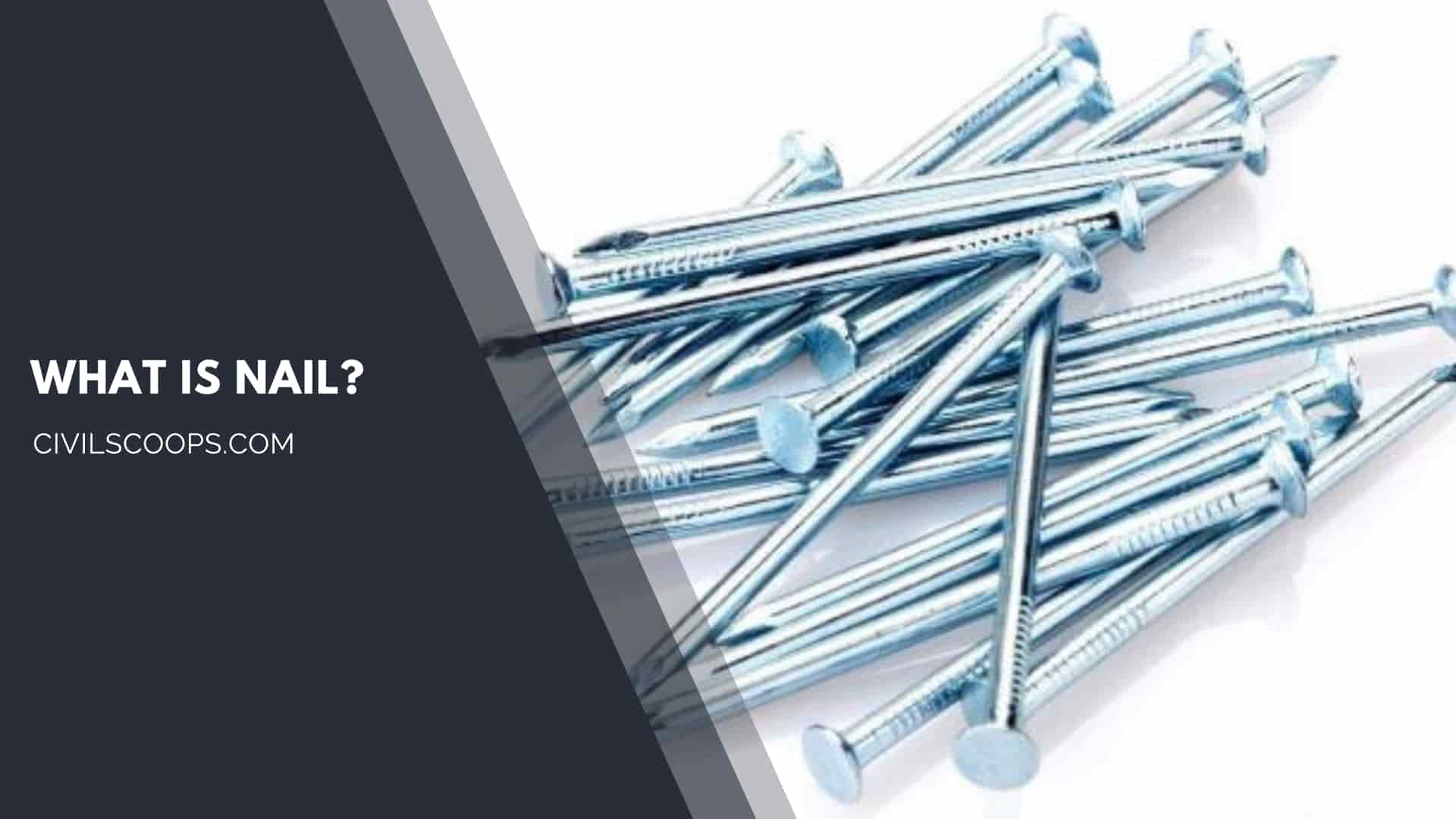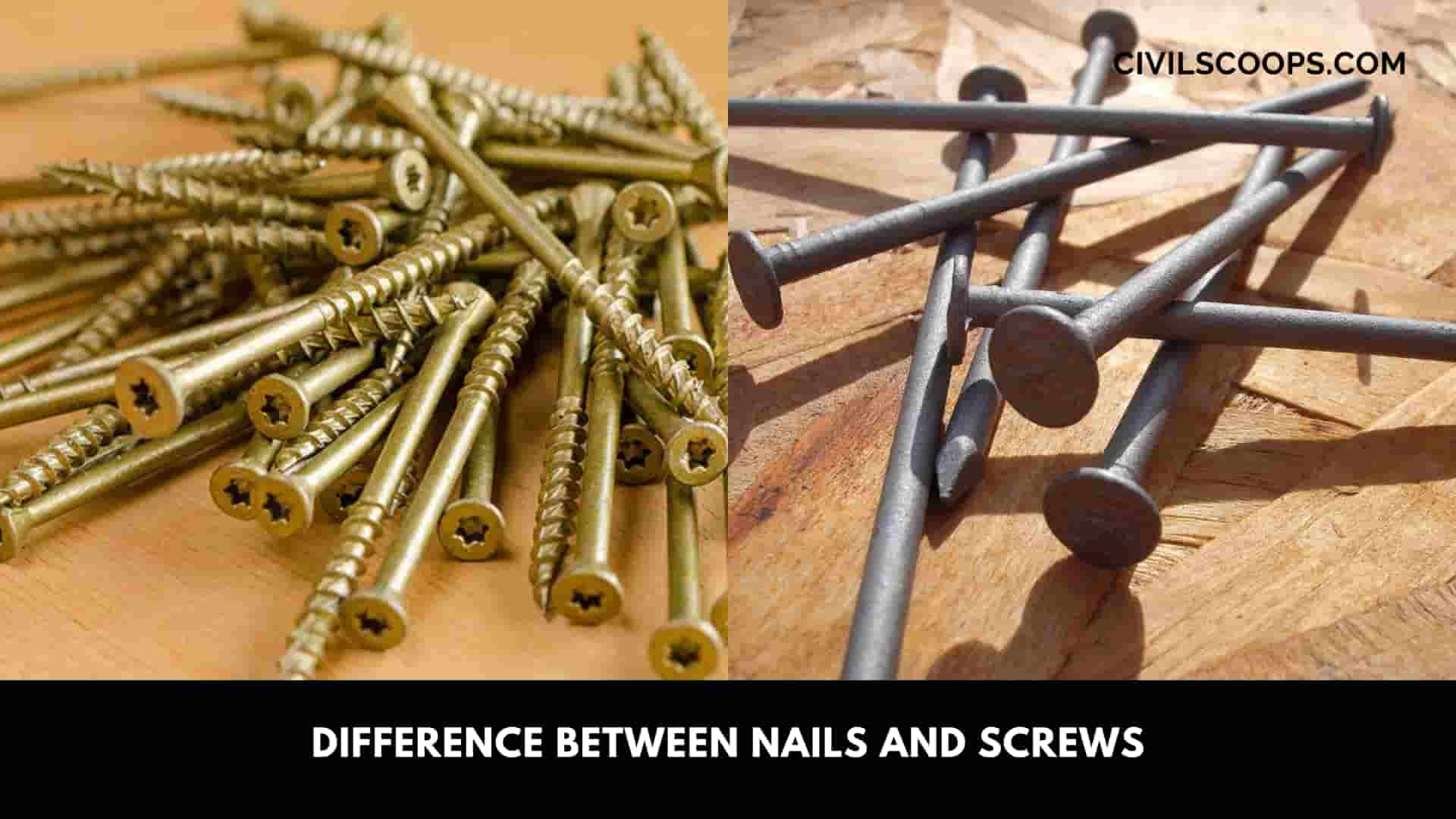Nail Vs Screw | What Are Nail | What Is Screw

Table of Contents
What Is a Nail?

Nail is the most common fasteners used in construction. Up to the end of the Colonial period, all nails used in the United States were handmade.
They were forged on an anvil from nail rods, which were sold in bundles. These nail rods were prepared either by rolling iron into small bars of the required thickness or by the much more common practice of cutting plate iron into strips by means of rolling shears.
Nail is available in a wide range of sizes, materials, and shapes, geared to a particular use or purpose Fastening with nail is the fastest and easiest way to connect wood members, requiring no predrilling or preparation, as they are driven into wood members with a hammer or a pneumatic gun.
Nail is most often made of mild steel but is available in a variety of other metals such as aluminum, copper, zinc, brass, or stainless steel.
While the rest of the world measures a nail’s diameter and length in millimeters. in the U.S. they are measured in a term called pennies and designated as d.
A 2d nail is one inch (25 mm) long, a 6d nail is two inches (51 mm) long, and a 10d nail is three inches (76 mm) long. The two types most often used in construction are common and finish nails.
Common nail has flat heads are used in most construction framing and are not intended to be exposed to the environment.
A galvanized nail has a protective zinc coating on them to inhibit rust and corrosion. Finish nail is not meant to be seen; they have a tiny head and are used in finished woodwork such as casework and interior detailing.
Other types of nails are box nails, casing nails, brad nails, roofing nails, cut nails, and concrete nails, each shaped differently in terms of its head, shaft, and point, to suit their particular use.
Also Read: All About of Corrosion | What Is Corrosion | 9 Different Types of Corrosion
What Is Screw?

A screw may be defined as an inclined plane wrapped around a nail and characterized by a helical ridge.
In other words, it is a long metal shaft with threads circling along its length. It also has a turning where a screwdriver can be used to rotate the screw.
A screw generally has a head with a specially formed shape. The shape determines and head’s size and the size of the tool to be used to turn or drive the screw. Commonly used tools are wrenches and screwdrivers.
The underside part of the head is a shank that can be fully or partially threaded. A screw thread is a structure on a coned or cylindrical shape in the form of a helix.
The top of the ridge is known as a crest and the bottom root. The distance between the crest of one thread to the next one is known as a pitch.
Screws are tightened by rotating the tool anticlockwise or clockwise and are usually used for joining materials that don’t have existing holes in them.
The most common types of screws used in manufacturing are drywall screws, dowel screws, mirror screws, and concrete screws.
The strength of a screw relies on the width of the thread and the distance between them. However, the more numbers of threads, the more rotations would be required to attach the screw.
Also, if the continuous distance thread is wider, more force must be exerted on the tool in the rotations.
Screws are widely used in many applications. From motorcycles to furniture, from air conditioners to kid’s remote control cars.
Also Read: Carbon Steel vs. Stainless Steel | What Is Carbon Steel | What Is Stainless Steel
Difference Between Nails And Screws

[su_table responsive=”yes” alternate=”no”]
| Sr.No. | Nails | Screws |
| 1 | The nail is less brittle, so they provide greater shear strength. |
Screws, on the other hand, may not be as forgiving, but their threaded shafts hold better in wood and draw boards together much more tightly and they have greater tensile strength.
|
| 2 | A nail and a screw because the shank on a nail is smooth and doesn’t have threads |
The screws look somewhat similar has threaded.
|
| 3 | A nail has more flexibility |
Screws have more tensile strength.
|
| 4 | Nail is fasteners with a flat head, smooth shank, and sharp point. |
Screws are fasteners with a drive located in the head and threading that protrudes down the length of the shank.
|
| 5 | Nail is driven by a hammer into materials to hold them together. They can be installed faster and are cheaper than screws. In this case (and to explain the theory), we will be using a smooth shank screw as our example. |
Screws (most of the time) require a pre-drilled hole and can often cut their own threads into materials they are rated for. For the sake of argument, we are going to be discussing a deck screw for this example. Deck screws are exceptionally engineered to hold two boards of wood together tightly and efficiently.
|
| 6 | Shear strength is the amount of force a fastener can handle from the sides. A nail has more elasticity than a screw. This means as forces are pushed against the sides of a nail, the nail can bend slightly to accommodate these pressures. |
A screw conversely has very little shear strength. Screws that are bent will almost always snap when trying to be straightened.
|
| 7 | Nail is often preferred for large projects, like house framing and installing hardwood floors, because they are typically stronger and less expensive than screws. |
Screws, in contrast, are favored for small and mid-sized projects, such as woodworking and decking, because they offer more control when inserting and extracting.
|
| 8 | Nail is often the first choice for framing, construction, and carpentry. |
Screws are a favorite fastener of woodworkers because, for example, they can be used to build jigs (temporary structures that guide and keep work consistent) for smaller projects like installing hinges.
|
[/su_table]
[su_box title=”FAQ” style=”default” box_color=”#333333″ title_color=”#FFFFFF” radius=”3″ class=”” id=””]
What Is the Difference Between a Nail and a Screw?
While they may sometimes look similar, these standard or custom fasteners are definitely not the same. Essentially, screws offer more resistance to breaking under tension, while nails have better resistance to motion.
How to Get Out Stripped Screws?
The best way to get a stripped screw out is to improve friction with a rubber band or an abrasive like steel wool. Using a larger screwdriver can be helpful. With a cross-shaped Phillips head screw, turning with a flat-head screwdriver provides added grip.
How Are Screws Sized?
A screw’s measurements are usually indicated as diameter x length, so a countersinking wood screw with a 5/32-inch diameter and a 1-1/2-inch length would be labeled as a #8 x 1-1/2-inch countersinking head wood screw.
How to Get Screws Out of Wall?
Pliers will allow you to get a firm enough grip on the screw to pull it out. Locking pliers or vise grip pliers work best. Grip the screw on the sides. Twist the screw gently right and left until you’ve loosened it enough to pull it out.
How to Get Screws Out?
Choose a drill bit that is slightly smaller than the head on the screw, then put the bit in the drill and tighten. Make sure the drill is in reverse and apply firm pressure to the screw head and start the drill. Once it bites there’s a good chance that it will remove the screw.
What Is a Lag Screw?
Also commonly known as lag bolts, lag screws are some of the toughest fasteners. These extremely sturdy fasteners are usually used to connect heavy lumber or other heavy materials that are bearing an intense load. These screws differ from normal wood, self-drilling or sheet metal screws.
What Is a Pan Head Screw?
Pan head screws are a common head type of non-countersunk screw head used to secure and fasten insulation. They have wide heads, a flat bearing surface, and a flat or slightly domed top surface with a recessed socket.
What Are Screws Used For?
The most common uses of screws are to hold objects together and to position objects.
What Does a Screw Look Like?
They have a corkscrew-shaped ridge, known as a thread, wrapped around a cylinder. The head is specially shaped to allow a screwdriver or wrench to grip the screw when driving it in. The most common uses of screws are to hold objects together — such as wood — and to position objects.
What Type of Screws for Drywall?
A bugle head screw is the most common and recommended for drywall. Bugle heads are countersunk and sit flush with the plasterboard, providing a great finish. Wafer head screws are commonly used to construct metal wall or ceiling frame systems and are not used to secure plasterboard.
Which Screws for Motherboard?
Standard motherboard screws are #6–32 x 3/16″ (sometimes 1/4″). M3 screws are also used, although less often than #6–32 screws.
Which Screws Are Best for Wood?
Wood Screws
#8 screws are standard and work well for most wood projects. Select a screw with a length that will penetrate half the thickness of the bottom material when fastening wood. A great choice for a standard wood screw is the Hillman #8 x 1-1/4-in. Silver Zinc-Plated Flat Interior Wood Screw.
[/su_box]
[su_note note_color=”#F2F2F2 ” text_color=”#333333″ radius=”3″ class=”” id=””]
Like this post? Share it with your friends!
Suggested Read –
- All About of Corrosion | What Is Corrosion | 9 Different Types of Corrosion
- What Are the Differences Between Shear Slump and Collapse Slump in Slump Test?
- Quality Testing of Sand for Concrete | Quality Testing of Sand for Construction | Types of Sand Test
- What Is Hempcrete | Hempcrete Blocks | Advantages & Disadvantages of Hempcrete Blocks | Applications of Hempcrete
- What Is Hard Hat | Hard Hat Colour Definition | Different Hard Hat Colour Codes | Types of Safety Helmets | Classification of Hard Hats
[/su_note]
Originally posted 2023-04-10 11:15:44.
